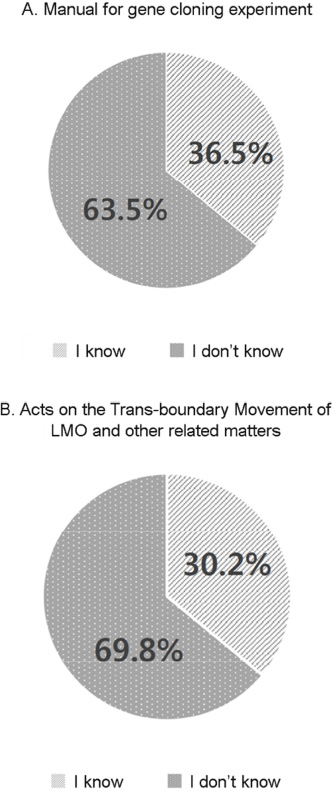J Bacteriol Virol.
2017 Jun;47(2):96-101. 10.4167/jbv.2017.47.2.96.
Survey on the Status of Biosafety Awareness Among Domestic Biology Researchers
- Affiliations
-
- 1Department of Microbiology, College of Medicine, Konkuk University, Seoul, Korea. wjjang@kku.ac.kr
- 2Internationl Vaccine Institute, Korea.
- 3Institute of Environmental Protection and Safety, Seoul National University, Seoul, Korea.
- KMID: 2384412
- DOI: http://doi.org/10.4167/jbv.2017.47.2.96
Abstract
- In this study, a survey was conducted to investigate the current status of biosafety awareness by each region, targeting domestic biology researchers. A total of 4 surveys were conducted from September 24 to October 2, 2013 in Kangwon province, Seoul Metropolitan area, Chungchong Province, and Gyeongsang Province, and 189 respondents participated in the survey. Of the survey respondents, 135 (71.4%) answered that "It is likely for an infection to happen in the laboratory" and 23 (12.2%) answered "highly likely". However, as to the Risk Group and Biosafety Facility Level, only 24 (12.7%) and 25 (13.2%) of the respondents, respectively, responded "know them very well". These results indicate that researchers are aware of the need for the concept of biosafety in laboratories, but they lack systematic education and publicity. Therefore, it will be necessary to develop a system that can systematically educate the regulations and compliance of biosafety.
Keyword
MeSH Terms
Figure
Reference
-
1. KCDC. Respiratory Disease Epidemiology Survey Results and Follow-up for Konkuk University. http://cdc.go.kr/CDC/intro/CdcKrIntro0201.jsp?menuIds=HOME001-MNU1154-MNU0005-MNU0011&cid=66463 2015.12.8;1-11.2. Orellana C. Laboratory-acquired SARS raises worries on biosafety. Lancet Infect Dis. 2004; 4:64.
Article3. Lee KM, Nam HY, Shin SH, Choi MK, Choi YJ, Kwon SH, et al. A Survey on Laboratory Biosafety Status of Public Healthcare Centers in Korea. J Bacteriol Virol. 2013; 43:217–228.
Article4. Martini GA, Schmidt HA. Spermatogenic transmission of the “Marburg virus”. Klin Wochenschr. 1968; 46:398–400.5. Oliphant JW, Parker RR. Q fever: Three cases of laboratory infection. Public Health Rep. 1948; 63:1364–1370.
Article6. Beeman EA. Q fever; An epidemiological note. Public Health Rep. 1950; 65:88–92.
Article7. Holmes GP, Hilliard JK, Klontz KC, Rupert AH, Schindler CM, Parrish E, et al. B virus (Herpesvirus simiae) infection in humans: epidemiologic investigation of a cluster. Ann Intern Med. 1990; 112:833–839.
Article8. Barton Behravesh C, Mody RK, Jungk J, Gaul L, Redd JT, Chen S, et al. 2008 outbreak of Salmonella Saintpaul infections associated with raw produce. N Engl J Med. 2011; 364:918–927.
Article9. Cho A, Seok SH. Ethical Guidelines for Use of Experimental Animals in Biomedical Research. J Bacteriol Virol. 2013; 43:18–26.
Article10. Lee KM, Choi YJ, Park KH, Jang WJ. The Management of Laboratory Biological Safety in Korea. J Bacteriol Virol. 2014; 44:342–351.
Article11. U.S. Department of Health & Human Services. Center for Disease Control and Prevention. National Institutes of Health. Biosafety in Microbiological and Biomedical Laboratories (BMBL). 5th ed. Washington D.C.: CDC/NIH;2009.12. World Health Organization. Laboratory biosafety manual. 3rd ed. Geneva: World Health Organization;2004.13. Lee JY, Eun SJ, Park KD, Kim JK, Im JS, Hwang YS, et al. Biosafety of microbiological laboratories in Korea. J Prev Med Public Health. 2005; 38:449–456.14. Kim JS, Lee HW. Studies on Microbiological Laboratory biosafety in Korea. Korean J Infect Dis. 1988; 20:133–146.15. Lee KM, Jang WJ, Choi YJ, Park KH. Emerging Infectious Diseases Require Biosafety Awareness and Procedures. J Bacteriol Virol. 2016; 46:104–107.
Article
- Full Text Links
- Actions
-
Cited
- CITED
-
- Close
- Share
- Similar articles
-
- Status of Laboratory Biosafety and Biosecurity in Veterinary Research Facilities in Nigeria
- A Survey on Laboratory Biosafety Status of Public Healthcare Centers in Korea
- A Literature Review on Asthma and Chronic Obstructive Pulmonary Disease Among Domestic and Overseas Farmers
- Biosafety of Microbiological Laboratories in Korea
- The Management of Laboratory Biological Safety in Korea




